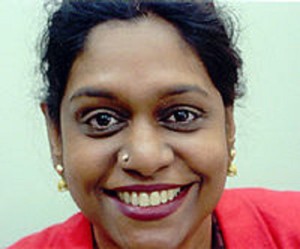English professor questions perceptions of race at Lovejoy Library lecture
During her lecture at Lovejoy Library Feb. 11 English Professor Anushiya Ramaswamy challenged popular notions of race as a social construct.

Dr. Anushiya Ramaswamy, English professor, discussed race as a projection of individual behavior during a Black Studies lecture at Lovejoy Library. (Courtesy Photo)
Titled “Is Mindy Kaling Black?” Ramaswamy argued that race is often performed in the ways an individual chooses to dress or behave.
Mindy Kaling, an American actress and author of South Indian descent, has made a name for herself in popular culture. Due to her dark skin, Dr. Ramaswamy said that Kaling would be considered dark-skinned or black in many American towns.
“She occupies a large space in American popular culture as a black artist, a black comic, a female black comic,” Ramaswamy said. “She appears in newspaper articles; she appears in magazines. She’s so big in a lot of ways. You don’t have an African American of the same stature. She in a lot of ways identifies with the white [culture].”
Ramaswamy said that while Kaling’s physical appearance more closely resembles a black person, her background makes her more similar to white Americans. Kaling dates white men, behaves like a white person and was educated at Dartmouth. The professor also noted that Kaling changed her birth name from Veeralakshmi Chockalingam to “Mindy Kaling” because the name was more easily accepted by the white culture. The lecture was part of a series scheduled by the SIUE Black Studies program.
“[Race] is not real,” Ramaswamy said. “That is my argument. You perform race, the same way you perform gender. If I’m presenting myself to you as female, then you treat me as female. If I’m presenting myself to you as white, then you will treat me as white.”
“Race, gender and class is always performed.”
Ramaswamy said that she chose a topic that would be identifiable and relatable to undergraduate students who attended the lecture along with some faculty. So Ramaswamy chose to discuss race as related to a pop culture figure.
Dr. Ramaswamy said that race is often constructed by social norms and what is considered desirable. In the case of race, white or “fair” skin tends to be desirable in many parts of the world, while darker skin is considered undesirable by colored people. And the race individuals choose to emulate is often based on desire. Desire that is perpetuated by a Western culture that favors white skin.
The professor cited an example in the 1951 experiment where researchers Kenneth Clark and Mamie Clark traveled to Charleston, South Carolina. The Clarks presented a white doll to 16 African American children under the age of 10. Seven chose the white doll as being more representative of them.
“Those children who chose the white doll as being most like them was because it is what they most desire,” said Ramaswamy, who studies class and race.
Dr. Ramaswamy also discussed Gandhi’s travels to South Africa in 1893 when the political activist went to organize Indians in the fight for civil rights against the British colonizers. Ramaswamy writes that Gandhi had no connections with the black Africans, and instead made connections with white politicians and writers, despite being treated similarly to a black man. Gandhi aligned with Indian Elites and clearly chose not to have any association with blacks.
Filed Under: African Studies • Asian Studies • Black Studies












